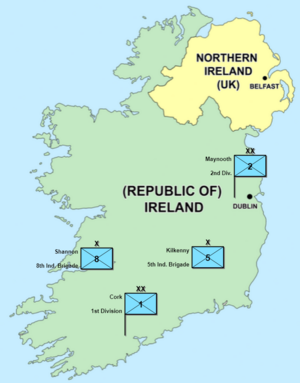1st Division (Ireland) facts for kids
Quick facts for kids 1st Division |
|
|---|---|
| XX | |
| Active | 9 May 1941 – 1945 |
| Country | |
| Branch | Irish Army |
| Type | Infantry |
| Size | Division |
| Garrison/HQ | Collins Barracks, Cork |
| Nickname(s) | Thunderbolt |
| Commanders | |
| Notable commanders |
Maj. Gen. Michael J. Costello |
The 1st Division, also known as "Thunderbolt", was a special group of foot soldiers in the Irish Army. It was active during World War II, a time when Ireland remained neutral.
This division was one of two main groups of soldiers created by Ireland during the war. The idea to form the 1st Division and the 2nd Division came from Oscar Traynor, the Minister for Defence. This happened on May 9, 1941, as Ireland decided to make its army stronger. The 1st Division had its main base at Collins Barracks, Cork, in the south of Ireland.
Why the Division Was Formed
When World War II started in 1939, Ireland declared itself neutral. This meant it would not pick sides in the war. However, after France was quickly defeated in 1940, Ireland worried it might be invaded. Its neutral status was at risk.
Before the war, experts thought Ireland would need three divisions to defend itself. But by September 1939, the army only had two small groups called brigades. These brigades were not strong enough. By early 1941, the army had grown to seven brigades, with over 40,000 soldiers.
To make the army even stronger, the government decided to create two large divisions. Minister for Defence Oscar Traynor gave the order on May 9, 1941. Six of the brigades were then grouped into these two new divisions. This left one brigade to work on its own.
How the Division Was Set Up
The 1st Division was made up of several smaller groups. Here is how it was organised:
- 1st Brigade, based in Clonmel
- 10th (Uisneach) Infantry Battalion (foot soldiers)
- 13th (Connacht) Infantry Battalion
- 21st Infantry Battalion
- 1st Field Artillery Regiment (soldiers who use large guns)
- 1st Motor Squadron (soldiers with vehicles)
- 3rd Brigade, based in Cork
- 4th Infantry Battalion
- 19th Infantry Battalion
- 31st Infantry Battalion
- 3rd Field Artillery Regiment
- 3rd Motor Squadron
- 7th Brigade, based in Limerick
- 9th (Desmond) Infantry Battalion
- 12th (Desmond) Infantry Battalion
- 15th Infantry Battalion
- 7th Field Artillery Regiment
- 7th Motor Squadron
Each brigade also had special teams. These included engineers, signal teams (for communication), and supply and transport teams. They also had medical teams and military police.
The division also had two Armoured Squadrons. These units used armoured cars and light tanks. There were also several cyclist squadrons. These were used to stop paratroopers (soldiers who jump from planes).
Colonel Michael J. Costello was promoted to Major General in May. He became the commander of the 1st Division. People said he was a "down to earth soldier." He made sure his division was very well prepared.
What the Division Did
During the war, the 1st Division mainly focused on training. They also guarded important areas in the south of Ireland.
In August and September 1942, the division took part in huge training exercises. These were called the Blackwater Exercises. The 1st Division practiced fighting against the 2nd Division. They worked on both attacking and defending. More than 20,000 soldiers and 1,500 vehicles were involved. This was the biggest training event ever for the Irish Defence Forces.
The training went well, but there were some challenges, especially with supplies. These problems were fixed with more training.
Major General Costello explained their training goals: "Because our army didn't have the best weapons or communication gear, we focused on being better than any invader at night. Small groups of soldiers would try to capture enemy weapons. We also practiced moving quickly across difficult land and becoming experts at shooting. We learned how to use mines and explosives. Our platoons (small groups of soldiers) practiced moving silently at night through unknown areas."
Even though the soldiers didn't get paid much and their living conditions were not great, they stayed positive. Their spirits remained high throughout this period, which was known as The Emergency in Ireland.


